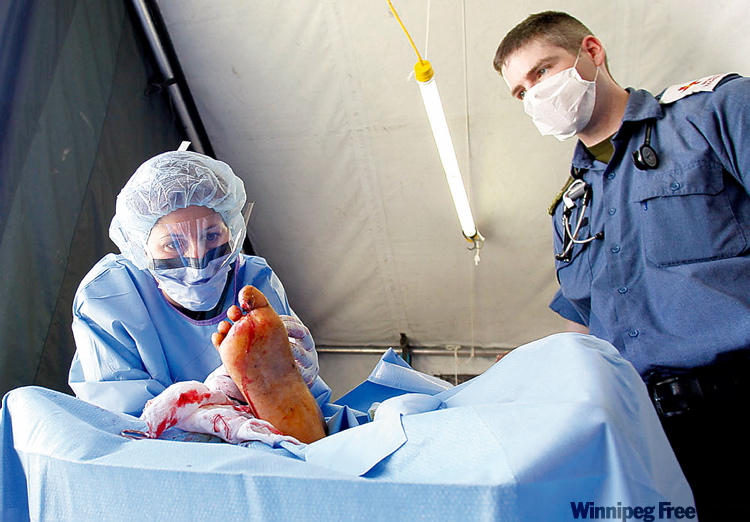Trying to save those they can
Canadian doctors, nurses treat injured in difficult conditions
Advertisement
Read this article for free:
or
Already have an account? Log in here »
To continue reading, please subscribe:
Monthly Digital Subscription
$0 for the first 4 weeks*
- Enjoy unlimited reading on winnipegfreepress.com
- Read the E-Edition, our digital replica newspaper
- Access News Break, our award-winning app
- Play interactive puzzles
*No charge for 4 weeks then price increases to the regular rate of $19.00 plus GST every four weeks. Offer available to new and qualified returning subscribers only. Cancel any time.
Monthly Digital Subscription
$4.75/week*
- Enjoy unlimited reading on winnipegfreepress.com
- Read the E-Edition, our digital replica newspaper
- Access News Break, our award-winning app
- Play interactive puzzles
*Billed as $19 plus GST every four weeks. Cancel any time.
To continue reading, please subscribe:
Add Free Press access to your Brandon Sun subscription for only an additional
$1 for the first 4 weeks*
*Your next subscription payment will increase by $1.00 and you will be charged $16.99 plus GST for four weeks. After four weeks, your payment will increase to $23.99 plus GST every four weeks.
Read unlimited articles for free today:
or
Already have an account? Log in here »
Hey there, time traveller!
This article was published 22/01/2010 (5793 days ago), so information in it may no longer be current.
LEOGANE, Haiti — The injured arrive on crutches and on stretchers, or cradled in the arms of distraught mothers. On a sun-baked soccer field turned Canadian field hospital, each new patient seems to present wounds more heartbreaking and severe than the one before.
Under a white canvas stretched between two military tents, nurse practitioner Carolyn Davies removes several maggots that have infested a gash on Therese Fleurant’s foot.
In the adjacent surgical tent, Vancouver doctor Donna Smith amputates a 16-year-old girl’s toe as she lies on a stretcher set upon a stack of cinder blocks.

Only a metre away, another amputation. British Columbia doctor Ray Markham is removing the right pinky finger of a young woman, whose blood drips into a pool on the canvas floor.
The conditions for treatment here would be considered raw and challenging by any standard, but they are made immeasurably more intense because the earth is rumbling from two aftershocks that occur even as the doctors do their work.
“This is tough. Lots of kids,” says Bill Coultart, a paramedic from Comox, B.C.
He is one of 16 members of the Canadian Medical Assistance Team who have deployed to Leogane, a city of 130,000 people and mounds of rubble about 30 kilometres west of Port-au-Prince.
“I had a kid come in about an hour ago with a plate-sized hole in his head right down to his skull,” says Coultart.
“It’s infected. Whether he’ll survive that, I don’t know. We do what we can.”
The first members of the Ontario-based NGO arrived in Haiti two days after the Jan. 12 earthquake destroyed or damaged about 80 per cent of Leogane’s buildings.
By Tuesday night, with help of a contingent of Canadian sailors from HMCS Athabaskan, they had erected a hospital that by Thursday had already received several hundred patients.
Nine days after the Jan. 12 earthquake, infections and gangrene have become so widespread among victims — particularly those with crush injuries — doctors fear they will have to perform dozens of amputations in the coming days and weeks.
“We can work all night if we could. There’s that many people,” says Smith, who practises medicine at St. Paul’s hospital in Vancouver.
Smith’s 16-year-old patient showed up at the Canadian clinic only on Thursday morning and quickly resigned herself to losing her toe. It was the best of several bad options.
The situation in Leogane — as in remote communities across the earthquake zone — is “only going to get worse” unless more help arrives soon, Smith says.
In Ottawa, Defence Minister Peter MacKay said more help is coming.
The Canadian Forces are deploying a military field hospital to the city, staffed by 100 doctors, dentists, surgeons and support staff.
The hospital will be equipped with an operating room, lab facilities and 50 minimum care beds.
“There is not a lot of infrastructure here. These people are the poorest of the poor, and now they are even poorer, so they need as much care as they can get,” said Valerie Rzepka, a 33-year-old Toronto nurse who serves as CMAT’s chairwoman.
— Canwest News Service

